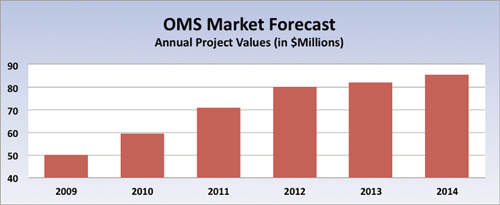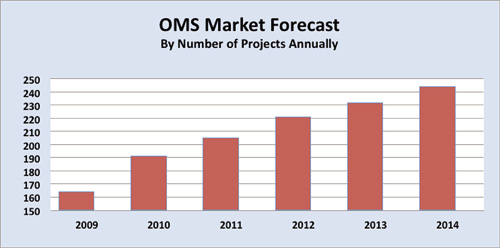Not so long ago a utility’s outage management system consisted of three main components: a call center, a radio dispatcher and a trouble ticket system –and for some utilities that’s still the case. While many of us might long for a return to those days, I think we can all agree that era is gone forever. In today’s world, a restive public will no longer tolerate even brief power interruptions limiting access to their electric appliances, creature comfort systems and other electric-powered conveniences. As a result, the growing importance of outage management as a utility discipline, with its need for increasingly more sophisticated outage response tools, has been a long and winding road that is finally coming to fruition with the availability of sophisticated new OMS systems.
During those early days when central computer systems were still rather unsophisticated, security standards were modest (at best) and Sarbanes-Oxley didn’t exist, implementation of advanced outage management systems with their outage filtering mechanisms and predictive restoration capabilities seemed very far off. Of course, a compliant customer base back then was not nearly so demanding that their local utilities provide good – and reliable – service.
Those old legacy systems went about as far as their limited data processing speeds and database management capabilities would take them, which was not very far. In-house IT staffs built many of the early outage management systems, which were not much more than simple work order systems with a hard printout, in the days before commercial-off-the-shelf (COTS) software and outside system integration specialists became the dominant players in the field. These days, computer speeds and advanced outage tracking capabilities, when coupled with the outage data coming from SCADA and smart metering systems, can process and filter large amounts of data and provide responders with much greater clarity when assessing the overall outage landscape than ever before.
Given the increasing emphasis placed by DOE, FERC, NERC and state regulatory commissions on improving network reliability, the market for sophisticated outage management systems is booming. Regulatory agencies have encouraged utilities to tighten reliability standards while at the same time implementing measures to moderate and shift peak system demand. DOE’s Smart Grid Investment Grant Program, for example, has provided matching funds for grid enhancements that focus on load shifting, while also improving reliability as measured by traditional power interruption metrics such as CAIDI, SAIFI and SAIDI. As electric utilities continue to focus on demand response for moderation of peak loads, regulatory emphasis on improving network reliability is expected to continue to increase.
Capital Budget Impact
One unfortunate characteristic of outage management systems is their necessary reliance on external data sources for success. Traditional sources of outage information such as SCADA, and of course the aforementioned utility call center, don’t provide the outage granularity needed to achieve quantum improvements in outage response. More recently, utilities have begun installing capital-draining network AMI systems with advanced metering functions that can provide power quality data including outage and low voltage alarms from each customer’s meter.
As these new AMI systems come on line and begin to fulfill their long-time promise, utilities will increasingly leverage the outage reporting capabilities of these systems through integration with OMS. For most utilities, however, this next adventure is yet to come as they attempt to recover from the huge impact of AMI implementation on their beleaguered capital budgets.
System Integration Can Be Challenging and Costly
Interestingly, for all of the industry hoopla over the new advanced IT infrastructures and interfaces such as Service Oriented Architecture and Enterprise Service Bus that use Web Services APIs, XML and SOAP protocols, relatively few fully integrated AMI and outage management systems that use these methods actually exist in the field today. Implementing these new IT architectures typically requires taking a holistic view of a utility’s entire IT infrastructure and assessing its impact on all enterprise level applications, including the utility CIS system. This transition can be a protracted and very costly endeavor.
And further complicating the utility enterprise application environment is the recent introduction of meter data management (MDM) systems to process large volumes of AMI data. MDM systems are designed to manage extensive amounts of meter data coming from their AMI systems and to broker events and alarms to other utility applications. Synchronization of OMS with the CIS, GIS and MDM systems is difficult to achieve, and typically requires utilities to engage outside system integrators at substantial cost. While standard OMS interfaces such as MultiSpeak do exist for some AMI to OMS interfaces, the complexities and real-time requirements of these system interfaces frequently require the use of vendor specific APIs created specifically for this purpose.
OMS Outlook is Strong
It is therefore not surprising that the market outlook for OMS systems is positive and sales are trending upward as an improving economy generates additional utility dollars for capital projects. The utility market research firm InfoNetrix has conducted some interesting research in this area, and as the chart below illustrates, more than $85 million is expected to be spent on OMS annually by 2014.

SOURCE: VISTA-Smart Grid Horizons Report; InfoNetrix LLC, New Orleans, Louisiana USA
And as I mentioned, required improvements in distribution network reliability are increasingly driving utility decision-making, and implementation of OMS is becoming essential for many utilities.
According to the data provided by InfoNetrix, the outlook for OMS expenditures is expected to be quite positive over the next 5-6 years, even though its winding road has often been quite bumpy. Once considered an optional or lower priority application, InfoNetrix has gained some interesting insights into the actual state of play for these systems, as summarized below.
• OMS will continue to enjoy strong growth, and is driven by NERC reliability guidelines, which have now become mandatory.
• Other regulatory bodies have begun placing emphasis on reliability improvements, which should produce continuing OMS market growth.
• OMS systems are becoming more sophisticated and will become more extensively integrated into utility distribution management systems.
• OMS systems will also become more integrated with utility work management and asset management systems in the future, which will increase their market value and integration costs.
Moreover, the study forecasts significant gains in the number of OMS projects during this same period, as implementation expands into the municipal and rural electric markets. The following chart reveals an upward trend in the sheer number OMS projects that are projected to take place during the same period:

SOURCE: VISTA-Smart Grid Horizons Report; InfoNetrix LLC, New Orleans, Louisiana USA
It is interesting to see that OMS implementation is no longer limited to just the larger investor owned utilities. InfoNetrix also forecasts significant growth in the number of smaller municipal and rural electric utilities that will install OMS systems, although these systems will likely be somewhat less sophisticated with fewer features and interfaces. According to InfoNetrix:
• The number of OMS projects will continue to increase at a steady pace over the next few years as utilities increasingly address reliability issues.
• Municipal and rural electric utilities will become more active concerning OMS deployment, but with more limited functionality, interfaces and cost.
• A smaller percentage of OMS projects will come from the investor owned utility sector as IOUs struggle to complete their AMI projects. Many of the integration issues discussed previously will come into play and could potentially drive up the cost of the more sophisticated installations.
• Over time, OMS projects will become increasingly more integrated with work management, field force management and asset management systems as they share data and pursue operating efficiencies
Older OMS systems will continue to operate and provide utilities with a base level of functionality that was adequate for the simpler times of the past. However, among the important issues going forward will be whether or not these older systems can be successfully integrated with newer AMI and MDM systems and whether the transition to newer IT architectures will force them into retirement.
The Road For OMS
The long and winding road of OMS development and implementation is surely not what the Beatles were describing with their hit song in 1970, even though many older trouble ticket systems do go back that far. I think even Paul McCartney would agree that writing a tune for the lengthy OMS story line would be a difficult task at best, since OMS is far from reaching the end of its road. Indeed, after nearly 40 years of implementation, we are finding that for OMS, the road is just beginning.
About the Author
 Ed Finamore is President of Valutech Solutions, Inc., a management consulting firm specializing in AMI systems and the Smart Grid. With over 35 years of utility automation experience, Mr. Finamore is a widely acknowledged industry expert and authority on smart metering systems and has authored many articles about various aspects of the Smart Grid. He received Electrical Engineering and MBA degrees from the University of Pittsburgh and is a Licensed Professional Engineer in the Commonwealth of Pennsylvania.
Ed Finamore is President of Valutech Solutions, Inc., a management consulting firm specializing in AMI systems and the Smart Grid. With over 35 years of utility automation experience, Mr. Finamore is a widely acknowledged industry expert and authority on smart metering systems and has authored many articles about various aspects of the Smart Grid. He received Electrical Engineering and MBA degrees from the University of Pittsburgh and is a Licensed Professional Engineer in the Commonwealth of Pennsylvania.







